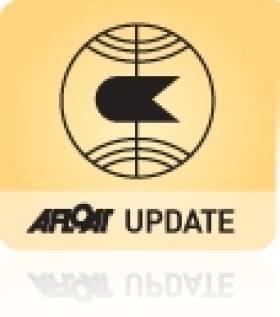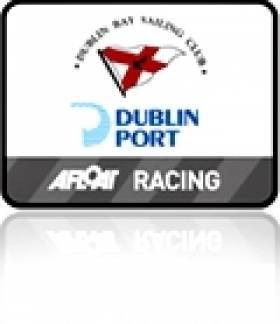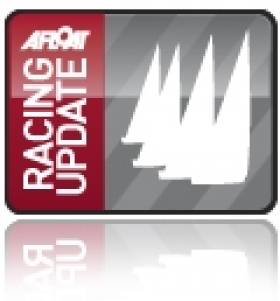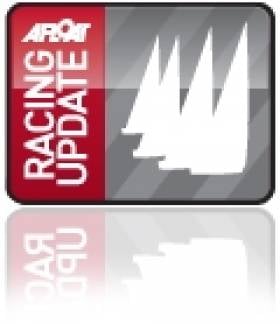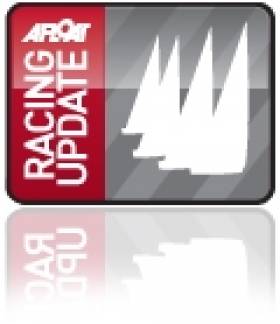Displaying items by tag: Ok
OK Dinghy Beats IDRA 14s for PY Frostbite Honours at DMYC
#dmycfrostbite – Winter ought to be over by now and the DMYC Frostbite series has come to the end of its 42nd year. Quite an institution. However, winter doesn't seem to be finished with us quite yet so 25-35 knot winds and temperatures of 2 degC confronted the fleets instead of the hoped-for Spring warmth.
The organisers and sailors left the decisions as long as possible in the hopes of one last race. There was no let up in the conditions and racing was cancelled for the day so the OK Dinghy didn't have to protect its lead in series 2. In any case, conditions at the RSGYC's slipway meant there was no way that the OK Dinghy could be launched. Enough of the easterly swell was reaching the slip to render any attempt at a launch both foolish and potentially dangerous....on that slipway at least.
However, the fleets took advantage of the lousy weather by heading for the DMYC where pints, prizes and Irish Tapas were the order of the day – along with some interesting announcements about the summer sailing.
In the PY fleet there were two sets of results up for grabs; the post-Xmas races in Series 2 and the Overall 2012/13 series.
The results in Series 2 were as follows:
OK Dinghy / Sheehy
GP14 / O'Brien & Sheridan
IDRA14 / Long & Rea
While the overall 2012/13 DMYC Frostbite series results were;
OK Dinghy / Sheehy
IDRA14 / Long & Rea
IDRA14 / Hamilton & Byrne
There was also a quick introductory talk about the activities of the Dún Laoghaire Dinghies team and the soon to be launched "Island Trial". These will be exciting additions to dinghy sailing on Dublin Bay in 2013
Sailors Use Smart Phones to Track Race Moves on Dublin Bay
#googleearth – Sailors with smartphones in their pockets can now get a birds eye review of their racing tactics thanks to Google Earth. That's what OK dinghy sailor Hugh Sheehy discovered last week in one of the final Dublin Bay Sailing Club races of the season.
Sheehy sailing in the handicap division against a variety of dinghies such as Finns, Lasers and radials included rival Paul Keane. Both Sheehy and Keane carried the smart phones afloat and were able to review their race afterwards.
The above youtube clip features the First leg of the second DBSC race. Keane's Laser track is in Red. The OK Dinghy in Green. It's not not clear why there's so much 'wobbling' in the OK Dinghy track, but we're sure its not tiller wagging!
The hope for the future, says Sheehy, is more sailors might carry smartphones out on to the water. Thanks to Google Earth's animated playback feature there'll be more chances to learn from your mistakes!
More on Hugh Sheehy's OK dinghy blog here
Nick Craig and Toby Lewis are 2011 'Endeavour' Champions
Craig, who has now won the event a total of five times, and Lewis who's won it three times, didn't have it all their own way however, and racing went down to the wire in the last of the eight-race series. Their biggest threat in today's final three races was the young, talented RS200 national champions – James Peters and Alan Roberts – who were leading the championship at the start of play today.

The Endeavour winners lift their trophy at the Royal Corinthian today. Photo: Sue Pelling
With two impressive race wins for Craig, two second places for Peters in today's first two races, and just two points between them, the scene was set for a spectacular showdown, and what a showdown it was.
Craig and Lewis did what came naturally in their vulnerable position by switching into match racing mode to ensure they were in control of Peters and Roberts' destiny. They did a particularly good job initially, which put them both at the tail end of the fleet but the canny youngsters were fully focussed which meant they were ready to pounce when Team Craig slipped up during a tack during the closing stages of the second beat. A coming together resulted in Craig and Lewis having to carry out penalty turns, which meant Peters and Roberts were able to slip ahead and maintain their controlling position to the finish. Unfortunately for them, however, it was too late to make any effect on the results, which meant Craig and Lewis had done enough to secure the championship.
An elated Craig talked impressively about his young opponents, and explained why they decided to use match racing tactics in the last race: "James is a great lad, great sailor, and I am sure he'll be back for more in the future. Today the two of them were extremely impressive. To be honest we were torn as to know what to do. We'd like to have just sailed the race but we decided that it was a bit risky not to match race because anything could have happened out there. It was shifty, and tidal, and if we mucked up and got behind, it would have been very difficult to get back in contention again."
Twenty-year-old Peters, who is in the RYA Olympic Development Squad and campaigning a 49er for a possible place at the 2016 Olympic Games, is one of the most impressive rookie Endeavour sailors the event has seen for many years. As well as a natural sailing talent, he demonstrated a professional side to his character which will undoubtedly see him progress well along his sailing career route. Chatting after the racing this afternoon, Peters commented: "We really enjoyed the event and it was a fantastic learning experience for us. Obviously Nick [Craig] won in the end but we felt we had to take all we could learn from the experience. Craig is a fantastic sailor. Although it is always tough to be match raced, it is important to understand that match racing in the situation we found ourselves in today is part of the sport of sailing. It is well within the rules and to execute it as Craig did, is a skill in itself, and he did a really good job making sure we weren't able to win. I have to say though, beating him across the line did make it a bit better for us, and finishing second at the Endeavour championship is amazing."
Racing once again took place at the mouth of the River Roach a couple of miles down stream from the host club, Royal Corinthian Yacht Club, and race officer, Kim Allen, and team did a first class job in setting some good, square, windward/leeward courses in the shifty, 10-14kts gusty, tidal conditions.
The competition on the racecourse was exceptionally high this weekend and it was noticeable how many young, new generation sailors are making their mark. In third place overall, after a tough battle was Scorpion representatives, Tom Jeffcoate and Mark Hogan who finished second in the final race which lifted them to third place overall.
Mention must also be made of the youth fleets including RS Feva representatives Owen Bowerman and Charlie Darling who, despite their extremely light, all-up weight, sailed impressively in every race and finished the event in a creditable 22nd overall.
Special thanks to the Endeavour Trophy sponsors which include the following: Topper, Allen Brothers, Calltracks, Hyde Sails, Selden, English Braids, Petticrows, Musto, Noble Marine.
Overall Results (after 8 races, and 1 discard)
1st OK – Nick Craig and Toby Lewis 15pts
2nd RS200 – James Peters and Alan Roberts 18pts
3rd Scorpion – Tom Jeffcoate and Mark Hogan 31pts
4th Osprey – Matt Burge and Richard Wagstaff 35pts
5th GP14 Stuart Bithell and Matt Johnson 40pts
6th Enterprise – Christian Birrell and Sam Brearey 40pts
Brief history of the Endeavour Trophy
The Endeavour Trophy is a solid silver scale model of the 'J' Class yacht Endeavour presented annually to the Champion of Champions at the Royal Corinthian Yacht Club, Burnham-on-Crouch.
The origin of the trophy stems from Tommy Sopwith's 'J' Class yacht Endeavour, America's Cup Challenge in 1934. Following a pay dispute and dismissal of his East coast-based professional crew, Sopwith enlisted the help of 'Tiny' Mitchell, the Commodore of the Royal Corinthian Yacht Club at the time, to recruit amateur members of the club to form a crew.
Although Endeavour won the first two races against Rainbow and lost the series, this was the closest England ever came to winning the coveted America's Cup.
Years later, Robin Judah – respected member of the RCYC – was anxious to establish a series of races for dinghy sailors in order to discover the 'Champion of Champions'. Beecher Moore, former Endeavour crew, and marketing man behind the successful dinghy designer Jack Holt, joined Judah in his quest to run this event and presented for the overall winner, his solid silver scale model of the yacht.
The first invitation-only race took place in 1961 and the winner was Peter Bateman, representing the International Cadet Class, crewed by Keith Musto. The original idea was to use the club's own fleet of 15 Royal Corinthian One-Designs but they were considered too specialist and would have placed a perpetual limit on the number of entries. Since then the event has been sailed numerous classes including the GP 14s, Laser 2s, Larks, Enterprises, RS400s and now the Topper Xenon.
Reviewing The Top OK Dinghy Gear
News that the OK Sailing Dinghy is knocking on the door in Ireland means it might be a good time to take a look at the gear used by the top 10 sailors at the recent OK Dinghy World Championships in Largs, Scotland. It would be easy to assume that New Zealand has somewhat of a monopoly on fast OK Dinghies. Five of the hulls, six of the sails and all 10 of the masts were of New Zealand origin in some shape or form. Robert Deaves reports.
The event this year was mainly held in light and shifty winds, so for some sailors the value this of data is perhaps reduced, however it is true to say that the top sailors rose to the top as they normally do. There were no real surprises.
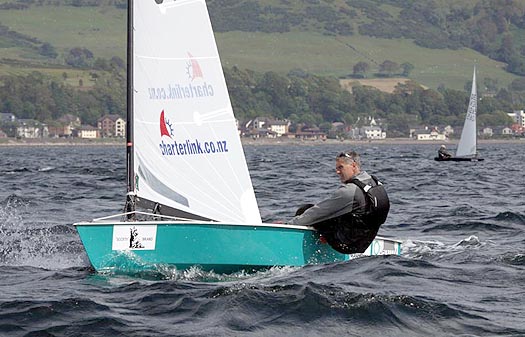
Alistair Deaves racing in Largs
To underline the competitiveness of this year's championship it is worth looking at the credentials of the top 10. Four were former World Champions, four were former Interdominion Champions, three were former Nordic Champions and eight were former National Champions. It was a top class field.
Hulls
The New Zealand made OK Dinghies from Icebreaker Boats NZ seem to be the boat of choice at the moment as many of the top sailors have chosen this builder. They have also won almost every major event of the past three years.
The Icebreaker shape goes back to the late 1960s when it was one of several designs from Alf Lock of Auckland. The fastest of his boats was used to take a mould and the Icebreaker came into existence. The boat has generally flat sections aft with minimal rocker and a fine entry to the bow. Upwind it tracks well and doesn't 'float' around as some of the fuller boats do. Offwind, while a fuller bowed boat would get into the plane slightly earlier, once the Icebreaker does, it has a faster top speed. In the light it is easy to handle and not as 'sticky' as some other designs.
Before 2008, Icebreaker hulls were really hard to get hold of outside New Zealand. The Kiwis didn't want the rest of the world to buy into their fast boats, and even though the mould passed through a number of hands, there was never much interest in exporting. But all that changed when Alistair Deaves took over the well used mould, refurbished it and to started to market the boat worldwide, no doubt helped by Karl Purdie (NZL) winning the 2008 World Championships in one of the first production boats.
However, according to Deaves, this is not the whole story. "The way the boat is constructed also plays a large part and Icebreaker Boats NZ has used modern computer design methods and materials to provide, what we think, is the best OK in the world. As much work as necessary is outsourced to ensure we get the best of everything."
"But of course the real reason why Icebreaker Boats NZ has such a good record is that we managed to sell to some of the best sailors, and perhaps that's the best endorsement of all. This is achieved by a policy of good quality and exceptional service, and customers often come back for new boats."
The moulding work for New Zealand Icebreakers is carried out in Auckland by Chris Brown of Performance Composites with the boats finished and marketed by Deaves through Icebreaker Boats NZ.
If it wasn't for the decline of the world economy, he says many more OK sailors would have chosen New Zealand made Icebreakers. "The import price was hiked out of reach for all but the rich and dedicated. In addition, some sailors pushed for copies of the Icebreaker to be made in Europe which has now led to three builders producing similar, but relatively cheaper copies."
Despite the crippling exchange rates some European buyers are still importing Icebreakers from New Zealand, though Deaves does admit that he has lost a lot of potential orders because of the complete nose dive in currency.
This season, like last season, Kiwi built Icebreakers have won most of the major events including the Interdominions, Spring Cup, Kiel Week, Warnemunde Week as well as many Nationals across Europe. It has also won five of the last seven world championships and last year's Europeans.
Ironically, though different NZ Icebreaker hulls won each and every race of this year's world championship, the highest place it achieved in the final overall standings was third. The championship was actually won by an Icebreaker copy, or Scolesbreaker, as it has been called, taken from Nick Craig's three times world championship winning New Zealand Icebreaker (though from a previous builder before Brown/Deaves) and built by Alex Scoles of UK based Idol Composites.
Though Craig sailed the most consistent series, by his own admission, he was not the fastest in the conditions at Largs. But, he said, "I am very pleased with my Scoles boat. Alex put in a lot of time ensuring the mould was perfectly fair, which has paid dividends with a fast and well-constructed boat that has a very long competitive life. It's nice to be able to focus on improving my rig whilst being 100% confident that my boat is fast."
Scoles commented, "It has been great for Idol Composites to have a world championship winning product and now my order book is bulging. The exchange rate has made Icebreaker Boats more expensive, but I don't think this had any significant impact on my orders so far."
In the last couple of years Idol Composites has sold OKs to the UK, Germany, Belgium, Ireland, Canada and Norway. This year it has had to take on extra staff and is looking to build more than 20 boats over the next 12 months. These are mainly for UK and Danish customers, though he also has potential orders from Sweden and Poland. Scoles also hopes to be able to ship a container full to Australia over the winter.
Idol composites offers what is considered the stiffest OK Dinghy available anywhere in the world. Everything is done in-house including the laminating, the painting and building the foils to maintain the high standards of build quality. As well as the standard gel coat finish, Idol Composites also offer 2-pack painted boats, which most of Scoles' customers opt for because of the saving in weight.
Scoles summed up his success, "It's a quality product together with a world title in a hull shape that OK sailors want." And that perhaps is the key. The Icebreaker shape is a shape from the past that everyone wants in the present.
However, all the other hulls in the top 10 are also old designs. The Hein is a German hull, with a fuller bow, the Rushworth is a copy of UK built Don O'Donnell hull from the 1970s and the Delfs copy is, as it suggests, a copy of the Swedish Delfs hull but built in Australia, with a full bow and very flat rocker that was very popular through the 1980s.
As ever there is nothing very new in the design of OK Dinghy hull shapes. As long as it is stiff, fair and down to weight, an old hull can be just as competitive as a new hull.
Masts
On an OK Dinghy, the mast is often considered the most important piece of kit. It is far more important that the hull or the sail, though of course the sail has to work with the mast to be any use. The move to carbon masts in 2004 sparked a lot of development worldwide, but in recent years the C-Tech mast from New Zealand has emerged as the most popular choice, principally after a lot of work from double world champion Karl Purdie (NZL). Even Craig has switched to a C-Tech after winning his first three titles with a Dutch built Celidh mast.
Out of any piece of kit on an OK Dinghy, C-Tech probably has the biggest market share. However, again, cost has become an issue as the exchange rate fell, opening up new development projects in Europe. But there is still some way to go on these.
Other masts in Largs included the UK built Aardvark and the Celidh.
Sails
Six out of the seven race wins in Largs were taken by sails built by Kiwis. Five of these were from Quantum Sails Potsdam, in Germany. The loft is run by Greg Wilcox, a former OK Dinghy world champion from New Zealand.
Wilcox, who himself finished fourth in Largs, explained, "Quantum Sails are individually made and matched to the sailor's weight, fitness level and, of course, mast bend. A lot of the other sails on the market are pre-made and the luff curve added last. This means there is really only one sail whereas we have a few different designs for different sailors."
"Our sails seem to have a bit of an edge when the conditions are quite varied. They seem to be very quick all round and especially downwind. I have worked with the top guys in the class like Karl Purdie and Thomas Hansson-Mild to develop the designs. They are both quite analytical and experienced and have provided very good feedback. I think this is obvious when they have won three of the last four worlds between them using these sails."
"Cloth choice is also very important however most sailmakers use Contender sailcloth which is very stable, light and reasonably durable. We try to get consistent cloth and work with our supplier towards this."
Craig used a UK built Speed sail, developed in conjunction with 2004 OK Dinghy World Champion Jim Hunt, but was never that happy with its light wind performance. Danish Green sails are very popular in Germany and Denmark and have been a key sailmaker for the class for decades. It's a similar story for Gale & Rimmington for Australia, though they tend to perform best in the windier conditions, something not experienced in Largs this year.
Other sails used in Largs include Pinnell & Bax from the UK, North from New Zealand, WB from Finland, Cicada from Germany and Linton from New Zealand.
Summary
Overall, whether by design or by choice, Kiwi knowledge and experience has produced some of the fastest combinations in the OK Dinghy in recent years and this trend looks set to continue. The main restriction for Europeans, and Americans, is the exchange rate, and before that returns to normality, if it ever does, the rest of the OK world needs to play catch up, or as in some cases, follow the same successful formula.
Table: Top 10 Gear at 2011 OK Dinghy World Championships
Shape Builder Sail Mast Board/rudder
1 Icebreaker copy Scoles Speed C-Tech Scoles
2 Hein. Hein Green C-Tech Hein
3 Icebreaker Icebreaker NZ Quantum C-Tech Jason King/KL
4 Icebreaker Icebreaker NZ Quantum C-Tech Deaves/C-Tech
5 Icebreaker Icebreaker NZ Linton/Quantum C-Tech Bumblebee
6 Rushworth Rushworth Quantum C-Tech Rushworth
7 Icebreaker Icebreaker NZ Green C-Tech Deaves
8 Icebreaker Icebreaker NZ Quantum C-Tech Deaves/C-Tech
9 Hein Hein Quantum C-Tech Hein
10 Jason King Delfs copy Gale & Rimmington C-Tech Jason King
Interest in OK Dinghy in Ireland
The OK dinghy is perhaps the most internationally active non-Olympic single handed dinghy. It's a classic design, but fully updated now with carbon mast to match the excellent handling. It's sailed in the UK, France, Belgium, Germany, the Nordics, Australia, New Zealand, and there's renewed activity in historically active countries like the Netherlands, the USA and Canada....with the Asian fleets - as always - small but persistent.
The class in Ireland is still small, but there's interest in both North and South, and a new class association website here
We're told there'll be a few boats on the water in 2012 to show off the advantages of this class, and there are several people interested in finding boats during next year.
Nick Craig Reflects on Fourth OK Dinghy World Title
Nick Craig chats to Robert Deaves after his record-equalling fourth OK Dinghy World title
How times have changed. A little over seven years ago, no British sailor had ever won the OK Dinghy World Championship. It was a commonly held belief in the class that no British sailor ever would. They were just not up to the job, or jinxed by 50 years of history. Jim Hunt changed all that in 2004 with a decisive win on home ground at Parkstone on the UK's south coast.
Then it was Nick Craig's turn, winning the title in 2005, 2006 and 2007 to become only the third person to win three titles and only the second to win three in a row. This year in Largs, Scotland, Craig won it for a record equalling fourth time after one of the trickiest and closest world championships ever held.
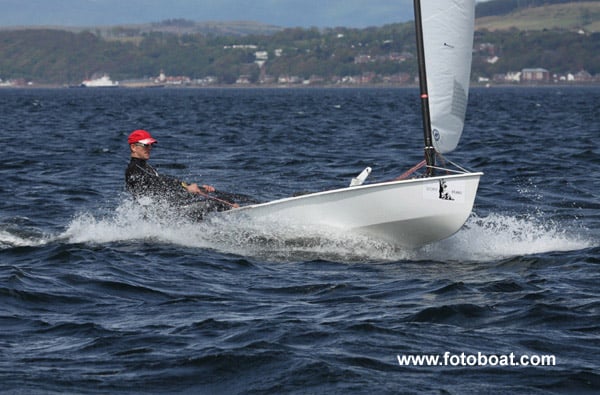
Craig joins Leith Armit (NZL), who won in 1983, 1985, 1990 and 1994, and Bo-Staffan Andersson (SWE) who won in 1988, 1991, 1992, 1993, as the only sailors to have won the title four times.
In addition, Craig rises to the top of the 'Best OK Dinghy sailors of all time' list, overtaking class legend Jørgen Lindhardtsen (DEN).
Several weeks after the win, Craig reflected on the regatta. It was not the easiest of weeks, plagued by light and unstable winds and unusually high temperatures. Only seven out of the ten scheduled races were held after several long days on the water with very little to show on the scoreboard.
Craig said, "However, it was a very well run event. On shore side, it was one of the best events I've done. The family and friends events were organised by Sue Byers. There were activities every day, which meant my wife and kids had a great time which is very important."
"It's just a shame the wind didn't play ball. The sailing was very challenging with light, unstable winds, but the race team made the best of it so we raced in the best conditions available."
What were his expectations going into it the regatta and how did that change during the week? "I was aiming to win but stayed pretty philosophical with the difficult conditions. I was sailing my best and if the wind was a bit random there wasn't a lot I could do about it. I didn't open the week well with a 16th and then an 11th in race three but I knew it would be high scoring so I just kept plugging away."
And the threats? "It was as expected – a great mix of experience in past World Champions Thomas Hansson-Mild (SWE) and Greg Wilcox (NZL) and new blood from Bartosz Rakocy (POL). In light winds I expected the German team to be fast which they were and in breeze the Aussies are fast."
After finding great speed in years past to win three world titles with his Celidh mast and North sail combination, Craig has struggled with speed issues in recent years, after the rest of the world caught up. And to some extent this still dogged him in Largs. "The biggest challenge was my lack of pace in the very light airs. I was just off the pace upwind in sub-hiking conditions, which made life very difficult on the big course. I was having to start very aggressively and get all the shifts right to get any decent results in these conditions."
The event had started on a low point for Craig. "My car, which was packed for the event and a two week family holiday, was stolen from the sailing club the weekend before the event and it made the week before very hectic with replacing the car, towbar, clothes, cot bed, credit cards and sailing kit as well as going to work. The biggest low point was how useless the police were – the thief phoned my wife on my phone so could easily have been caught."
And once into the racing, he didn't have the best start. "The opening race was pretty horrible for me. I got a great start but my pace was ordinary, I got on the wrong side of the last shift into the windward mark, and then got killed when the second reach turned into a run so I just scraped a 16th."
However the championship was still wide-open going into the seventh and final race, held right on the time limit. Craig, who was in fourth place overall, needed things to go his way. "The highlight of the event for me was the first beat of the last race. I got a bit lucky - there was a shift and new breeze on the left which I was in so I rounded the top mark first with none of my competition in the top 20."
"After that stroke of good fortune, it was still a tricky race. The wind stayed very light and I again struggled a bit for pace so slipped to fourth through the race whilst Greg Wilcox was coming through quickly. The run was painful as the leeward marks were moved to make it longer and the wind filled in from behind so at one point it looked like I'd be engulfed by the chasing pack. The fleet then inevitably split at the leeward gate but thankfully the wind filled in on my side so I clung on to take the title by just two points."
What does a fourth world title mean to him? "It means a lot – winning it this time round was in many ways a lot harder than any other time as I'm sailing less so it's harder to get an edge."
"The rigs have also moved on a lot over the last few years and I've been behind as I've been sailing other boats and doing less sailing. But I'm happy that I've now got a rig that works well across the wind range. I've got no edge though, so I'll be trying a few things over the winter to find that edge again."
Craig is without doubt an OK Dinghy fanatic, but sees the need for the class to promote itself in a crowded market. "The class needs to keep playing to its strengths of great international racing and low cost close racing in a good fun atmosphere. It is hard to promote that in the UK because it is a very crowded market and there are big companies promoting their boats hard. But the OK has a unique mix of enjoyable racing that should see it continue to thrive."
The class has lined up some great venues for the next few years. In 2012 the world championship is being held in Denmark, while in 2013 the class heads to Thailand for the first time, before travelling down under to Melbourne in 2014.
Craig is certainly game to try for a record fifth world title. "It would be fantastic and I will go for it, more because I love racing the OK Dinghy internationally than because five is a magic number. I hope to have many more years of great international sailing and beer drinking."
"But I know it will be hard. There is some great young talent coming through the class as well as some very experienced hands who are tough to beat."
Photo by Alan Henderson, fotoboat.com


























